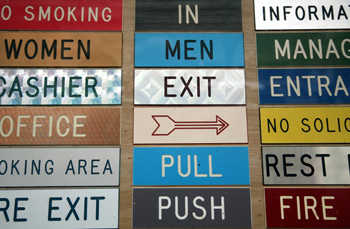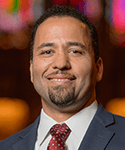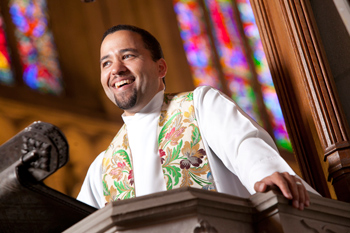Editor’s note: Faith & Leadership offers sermons that shed light on issues of Christian leadership. This sermon was preached July 29, 2009, in Duke Divinity School’s Goodson Chapel for worship at the Course of Study for Ordained Ministry.
We human beings are not too good at reading the signs.
On the door to my office hangs one of my favorite Gary Larsen “Far Side” cartoons. In it a somewhat nerdy-looking boy is trying to enter the Midvale School for the Gifted. He’s carrying a book under one arm and leaning with his other arm, with all his weight, against the door, straining, trying to push open the door. On the door there is a sign in great big letters that explains his problem. It reads, “PULL.”
That’s us. We’re not too good at reading the signs.
But that’s also the people Jesus dealt with. All throughout the Gospels, people are coming up to Jesus and asking for a sign from heaven. Jesus will perform one sign or wonder or healing, more than John says he can even tell us about, but then the people will just ask for another sign. Even when Jesus is dragged before King Herod just before he’s murdered, Luke tells us that Herod was kind of excited to meet him because he wanted to see Jesus do some sign.
Seemingly everybody who meets Jesus in the Gospels wants some sign, but when they get one they still don’t seem to be able to read those signs for what they mean. They’re pushing at a door that says, “Pull.” At one point, Jesus throws up his hands in exasperation and says, “You people look up in the sky, and you see some dark, cumulonimbus clouds gathering up, and you’re perceptive enough to say, ‘Uh, oh, it’s going to rain.’ And when you see the south wind blowing signaling summer, you realize that hot weather is on the way, you put on your shorts and T-shirts, and sure enough, the thermometer goes through the roof. You can interpret the signs of the sky. Why can’t you interpret what it means that I am here?”
We’re not too good at reading the signs; at least, not the signs that matter.
Neither are the disciples in our Gospel story. The disciples are sitting there opposite the massive megachurch, St.-Peter’s-Cathedral-sized, Mall-of-America-looking Temple, gaping at the shining stones and dazzling jewels, perhaps thinking silently that the Temple building, the central pivot point of Judaism, is what connects them to God. Then Jesus, unimpressed, tells them, “All of that is going to be nothing more than a pile of rubble.” The disciples, shocked, ask, “Teacher, when will this be? What will be the sign that this will take place?”
They want to know when the Temple will be destroyed. They want a sign to look for. Maybe they’re expecting Jesus to tell them something kind of esoteric and mysterious, some hidden knowledge like, “In the month of April, a blackbird with red eyes will land on the steeple and caw three times. It will then be eaten by a hawk wearing a purple sash and suddenly lightning will strike on the north portico and crop circles will appear in the cornfield and then you’ll know” … or something like that.
I can’t help but chuckle at Jesus’ very different answer, because it’s so obvious. The sign is not esoteric, hidden or mysterious at all. Basically Jesus tells them, “Well, when you see a great big old army camped around the Temple about to take it over, and they have really big weapons, well, that’s going to be the end of it. They’re going to tear it down.” Here’s your sign. And then Jesus says, “And when you see a great big angry-looking army about to take over the city of Jerusalem, here’s my advice. Run. Don’t be prideful or brave. Head for the hills.”
There’s no mysterious sign here. It’s a very obvious sign. Even disciples who aren’t very good at reading signs, who are always pushing on doors that say “Pull” can get this one. It’s like Jesus says, “Trust me, you’ll know when it’s happening. The sign will be obvious and right in front of you.”
Sure enough, around the year A.D. 70 a large Roman army will encamp around the Temple, and eventually they will raze it to the ground: not one stone left on another, every one of them thrown down.
The sign Jesus gave could be trusted.
In the next breath, though, Jesus goes on to speak of other signs. Jesus moves from describing the signs of the destruction of the Temple to describing the signs that will be seen when he returns, when he comes again in final victory. And again, his message seems to be that signs of the final victory will be obvious. They won’t be esoteric or mysterious or hidden. He says, “There will be signs in the sun, the moon, and the stars, the roaring of the sea, people fainting, the powers of the heavens shaken, the Son of Man coming in a cloud.”
It’s as if Jesus is saying, “In my first coming, I came in hiddenness, born in a manger, cloaked in flesh, visible only to the eyes of faith. But when I come again in fullness, it will be in power and glory.” It won’t be hidden. It will be obvious to all, like when you go to the eye doctor and they ask you to read the largest line of letters on the eye-chart first. The signs will be that clear to see.
And again, the sign Jesus gives can be trusted.
I don’t know about you, but if tomorrow I were to see crazy stuff happening in the sun and moon and stars and then see the Son of Man surfing a stratus cloud up at the sky, I won’t need a prophet or an expert in the parousia to let me know that maybe something’s going on. So Jesus makes the point that the signs of the Second Coming, the unveiling, the final victory, whatever it will look like, will be obvious when it arrives. We don’t have to read the tea leaves or get out the Ouija board or read books on prophecy or look for signs of when it is near.
In a sense, it is always near. And when it comes in its fullness, Jesus says, “Trust me, you’ll know.” So we don’t have to be like the little kid on the long car trip who keeps asking every ten minutes, “Are we there yet?” “Are we almost there yet?” When we get there, we’ll know.
In the meantime, we can know that we are almost there, because the signs that Jesus performed are signs that the Kingdom of God has already broken in among us. God’s future has entered our present. It is at hand, as close as the hand at the end of our arm. At hand. The kingdom is coming. That train has left the station, and we can hear its far-off whistle. It’s coming, and it’s coming, Scripture tells us, “soon.” Soon could mean tomorrow, it could mean a thousand years from now, but soon means it’s coming. Soon means we are one day closer to it today than we were yesterday.
The kingdom is near, and it’s coming with all its fullness soon. And until then, I can’t help but think that Jesus is more interested in the signs to be seen here on earth, than the signs to be seen in the heavens -- not signs in the sun and moon and stars, but signs in me and you and us. We’re not so much looking for signs, we are signs. Signs of God’s kingdom. We are the sign before the signs. We live the heavenly life here on earth, signs pointing to God’s good future and final victory.
The theologian Karl Barth had a painting of the crucifixion in the wall of his study that was painted by the artist Matthias Grunewald. In the painting there is an image of John the Baptist, his extra long finger raised this way, directing and pointing the onlooker to the cross of Jesus in the center of the painting. It’s said that when Barth would talk with a visitor about his work, he would direct them to John the Baptist in the painting, and he would say, “I want to be that finger.” I want to be a sign pointing to the victory of Christ.
We are the people who have read the end of the book. We know how the story ends. We know God wins. And so we as God’s people, in our life of love together, it’s not that we stand on a corner holding a sign that says “The End is Near.” But we live in such a way that our life is a sign reading “The New Beginning is Near.” We are the beachhead of the kingdom. We’re like the preview or trailer of the movie that makes people look forward to seeing the full show. We’re like the warm-up act that gets people pumped up for the concert that is about to begin. We’re the appetizer that makes people hunger for the full feast -- like the lady at the ice cream shop who lets me get a taste of Chunky Monkey before she hands me the full cone. People don’t have to travel through time on a mysterious island or gaze into a crystal ball to look into the future. They can simply look at the life of the faithful, loving Christian.
The sign Jesus gives can be trusted.
On a crisp day last fall, stepping out of my car and walking up towards the porch of my home in the evening, I noticed a bright, red sycamore leaf that had fallen and lay by itself in my yard. It was so bright red it looked like it was on fire, and it was so beautiful and different from the green and brown grass that it was laying on that you couldn’t help but notice it. It was different. That bright red leaf was the first leaf of fall. And in that way, it was a kind of sign. Lying there, it told me, “More are coming after me so get the rake ready.” But it says, “Fall is coming. A change is coming. Beauty is coming. Believe it.”
“Look at the fig tree and all the trees,” Jesus says. “As soon as they sprout leaves you can see for yourselves and know that summer is already near. So also, when you see these things taking place, you know that the kingdom of God is near.”
We are that leaf. We are ahead of time. We are signs of the change that is coming, of the beauty that is about to follow. We can shine that brightly and be that beautiful. We don’t wait for the world to change, or for everything else to change its color. We can go ahead and be changed. We can point others to what is coming and live the heavenly life now. We can be a sign of God’s shalom.
This world will set up all kinds of signs for people, telling them -- us -- which way to go.
Some tell people to push when the door really only opens with a pull. Most of them are stop signs. Most of them say that the road we are travelling on is a dead end. There is no way you can go.
The church sets up another sign in the world: “Coming Soon.”
We are a sign.
A soon sign.
And the sign Jesus gives can be trusted.















